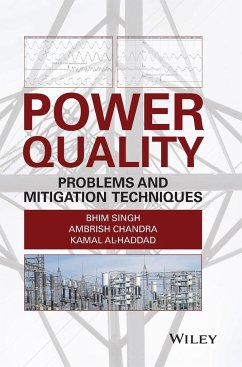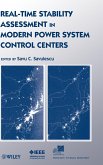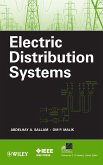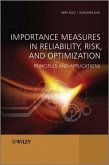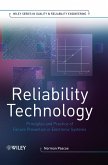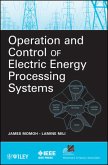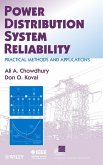- Gebundenes Buch
- Merkliste
- Auf die Merkliste
- Bewerten Bewerten
- Teilen
- Produkt teilen
- Produkterinnerung
- Produkterinnerung
Maintaining a stable level of power quality in the distribution network is a growing challenge due to increased use of power electronics converters in domestic, commercial and industrial sectors. Power quality deterioration is manifested in increased losses; poor utilization of distribution systems; mal-operation of sensitive equipment and disturbances to nearby consumers, protective devices, and communication systems. However, as the energy-saving benefits will result in increased AC power processed through power electronics converters, there is a compelling need for improved understanding of…mehr
Andere Kunden interessierten sich auch für
![Real-Time Stability Assessment in Modern Power System Control Centers Real-Time Stability Assessment in Modern Power System Control Centers]() S C SavulescuReal-Time Stability Assessment in Modern Power System Control Centers159,99 €
S C SavulescuReal-Time Stability Assessment in Modern Power System Control Centers159,99 €![Electric Distribution Systems Electric Distribution Systems]() SallamElectric Distribution Systems133,99 €
SallamElectric Distribution Systems133,99 €![Importance Measures in Reliability, Risk, and Optimization Importance Measures in Reliability, Risk, and Optimization]() Way KuoImportance Measures in Reliability, Risk, and Optimization128,99 €
Way KuoImportance Measures in Reliability, Risk, and Optimization128,99 €![Insulators for Icing Insulators for Icing]() Masoud FarzanehInsulators for Icing204,99 €
Masoud FarzanehInsulators for Icing204,99 €![Reliability Technology Reliability Technology]() Norman PascoeReliability Technology113,99 €
Norman PascoeReliability Technology113,99 €![Operation and Control of Electric Energy Processing Systems Operation and Control of Electric Energy Processing Systems]() Operation and Control of Electric Energy Processing Systems105,99 €
Operation and Control of Electric Energy Processing Systems105,99 €![Power Distribution System Reliability Power Distribution System Reliability]() Ali ChowdhuryPower Distribution System Reliability173,99 €
Ali ChowdhuryPower Distribution System Reliability173,99 €-
-
-
Maintaining a stable level of power quality in the distribution network is a growing challenge due to increased use of power electronics converters in domestic, commercial and industrial sectors. Power quality deterioration is manifested in increased losses; poor utilization of distribution systems; mal-operation of sensitive equipment and disturbances to nearby consumers, protective devices, and communication systems. However, as the energy-saving benefits will result in increased AC power processed through power electronics converters, there is a compelling need for improved understanding of mitigation techniques for power quality problems.
This timely book comprehensively identifies, classifies, analyses and quantifies all associated power quality problems, including the direct integration of renewable energy sources in the distribution system, and systematically delivers mitigation techniques to overcome these problems.
Key features:
- Emphasis on in-depth learning of the latest topics in power quality extensively illustrated with waveforms and phasor diagrams.
- Essential theory supported by solved numerical examples, review questions, and unsolved numerical problems to reinforce understanding.
- Companion website contains solutions to unsolved numerical problems, providing hands-on experience.
Senior undergraduate and graduate electrical engineering students and instructors will find this an invaluable resource for education in the field of power quality. It will also support continuing professional development for practicing engineers in distribution and transmission system operators.
Hinweis: Dieser Artikel kann nur an eine deutsche Lieferadresse ausgeliefert werden.
This timely book comprehensively identifies, classifies, analyses and quantifies all associated power quality problems, including the direct integration of renewable energy sources in the distribution system, and systematically delivers mitigation techniques to overcome these problems.
Key features:
- Emphasis on in-depth learning of the latest topics in power quality extensively illustrated with waveforms and phasor diagrams.
- Essential theory supported by solved numerical examples, review questions, and unsolved numerical problems to reinforce understanding.
- Companion website contains solutions to unsolved numerical problems, providing hands-on experience.
Senior undergraduate and graduate electrical engineering students and instructors will find this an invaluable resource for education in the field of power quality. It will also support continuing professional development for practicing engineers in distribution and transmission system operators.
Hinweis: Dieser Artikel kann nur an eine deutsche Lieferadresse ausgeliefert werden.
Produktdetails
- Produktdetails
- Verlag: Wiley & Sons
- 1. Auflage
- Seitenzahl: 600
- Erscheinungstermin: 16. Februar 2015
- Englisch
- Abmessung: 250mm x 175mm x 36mm
- Gewicht: 1199g
- ISBN-13: 9781118922057
- ISBN-10: 1118922050
- Artikelnr.: 41430829
- Herstellerkennzeichnung
- Libri GmbH
- Europaallee 1
- 36244 Bad Hersfeld
- gpsr@libri.de
- Verlag: Wiley & Sons
- 1. Auflage
- Seitenzahl: 600
- Erscheinungstermin: 16. Februar 2015
- Englisch
- Abmessung: 250mm x 175mm x 36mm
- Gewicht: 1199g
- ISBN-13: 9781118922057
- ISBN-10: 1118922050
- Artikelnr.: 41430829
- Herstellerkennzeichnung
- Libri GmbH
- Europaallee 1
- 36244 Bad Hersfeld
- gpsr@libri.de
Professor Bhim Singh has worked at the IIT Delhi Department of Electrical Engineering since 1997. He has 30 years' experience in research, consulting and teaching, has organized more than 40 short term courses and workshops, and has delivered more than 100 invited specialized lectures. He has chaired many international and national conferences, including the IEEE International Conferences on Power Electronics, Drives and Energy Systems in 2006. Professor Singh holds one US and one Indian Patent and has filed nine Indian patents. He is a Fellow of many engineering institutions including the Indian National Academy of Engineering and the Indian Academy of Sciences. Professor Ambrish Chandra became a Professor in Electrical Engineering Department at ETS in 1999. His main research interest areas are: power quality, active filters, static reactive power compensation, FACTS and control & integration of renewable energy resources. Professor Chandra is a Fellow of many engineering institutions including IEEE, IET (UK), IE (India) as well as a Life Member of the Indian Society for Technical Education (ISTE). Professor Kamal Al-Haddad has been a Professor within ETS' Electrical Engineering Department since 1990. His research interest areas include: high efficient static power converters, harmonics & reactive power control using hybrid filters, switch mode & resonant converters, the development of prototypes for various industrial applications in electric traction, and power supply for drives & telecommunication. Professor Al-Haddad is an IEEE Fellow, a Canadian Academy of Engineering Fellow and life member of the Circle of Excellence of the University of Quebec. Presently he is IEEE Industrial Electronics society President Elect.
Preface xi
About the Companion Website xiv
1 Power Quality: An Introduction 1
1.1 Introduction 1
1.2 State of the Art on Power Quality 2
1.3 Classification of Power Quality Problems 3
1.4 Causes of Power Quality Problems 4
1.5 Effects of Power Quality Problems on Users 4
1.6 Classification of Mitigation Techniques for Power Quality Problems 6
1.7 Literature and Resource Material on Power Quality 6
1.8 Summary 7
1.9 Review Questions 8
References 8
2 Power Quality Standards and Monitoring 11
2.1 Introduction 11
2.2 State of the Art on Power Quality Standards and Monitoring 11
2.3 Power Quality Terminologies 12
2.4 Power Quality Definitions 15
2.5 Power Quality Standards 16
2.6 Power Quality Monitoring 18
2.7 Numerical Examples 20
2.8 Summary 39
2.9 Review Questions 39
2.10 Numerical Problems 40
2.11 Computer Simulation-Based Problems 43
References 46
3 Passive Shunt and Series Compensation 48
3.1 Introduction 48
3.2 State of the Art on Passive Shunt and Series Compensators 48
3.3 Classification of Passive Shunt and Series Compensators 49
3.4 Principle of Operation of Passive Shunt and Series Compensators 51
3.5 Analysis and Design of Passive Shunt Compensators 51
3.6 Modeling, Simulation, and Performance of Passive Shunt and Series
Compensators 62
3.7 Numerical Examples 63
3.8 Summary 85
3.9 Review Questions 85
3.10 Numerical Problems 87
3.11 Computer Simulation-Based Problems 89
References 93
4 Active Shunt Compensation 96
4.1 Introduction 96
4.2 State of the Art on DSTATCOMs 96
4.3 Classification of DSTATCOMs 97
4.4 Principle of Operation and Control of DSTATCOMs 108
4.5 Analysis and Design of DSTATCOMs 133
4.6 Modeling, Simulation, and Performance of DSTATCOMs 136
4.7 Numerical Examples 141
4.8 Summary 158
4.9 Review Questions 158
4.10 Numerical Problems 159
4.11 Computer Simulation-Based Problems 162
References 167
5 Active Series Compensation 170
5.1 Introduction 170
5.2 State of the Art on Active Series Compensators 171
5.3 Classification of Active Series Compensators 171
5.4 Principle of Operation and Control of Active Series Compensators 178
5.5 Analysis and Design of Active Series Compensators 183
5.6 Modeling, Simulation, and Performance of Active Series Compensators 185
5.7 Numerical Examples 190
5.8 Summary 216
5.9 Review Questions 217
5.10 Numerical Problems 218
5.11 Computer Simulation-Based Problems 220
References 226
6 Unified Power Quality Compensators 229
6.1 Introduction 229
6.2 State of the Art on Unified Power Quality Compensators 230
6.3 Classification of Unified Power Quality Compensators 231
6.4 Principle of Operation and Control of Unified Power Quality
Compensators 237
6.5 Analysis and Design of Unified Power Quality Compensators 246
6.6 Modeling, Simulation, and Performance of UPQCs 249
6.7 Numerical Examples 252
6.8 Summary 292
6.9 Review Questions 292
6.10 Numerical Problems 293
6.11 Computer Simulation-Based Problems 297
References 303
7 Loads That Cause Power Quality Problems 306
7.1 Introduction 306
7.2 State of the Art on Nonlinear Loads 307
7.3 Classification of Nonlinear Loads 308
7.4 Power Quality Problems Caused by Nonlinear Loads 313
7.5 Analysis of Nonlinear Loads 314
7.6 Modeling, Simulation, and Performance of Nonlinear Loads 314
7.7 Numerical Examples 314
7.8 Summary 327
7.9 Review Questions 328
7.10 Numerical Problems 329
7.11 Computer Simulation-Based Problems 330
References 334
8 Passive Power Filters 337
8.1 Introduction 337
8.2 State of the Art on Passive Power Filters 338
8.3 Classification of Passive Filters 338
8.4 Principle of Operation of Passive Power Filters 344
8.5 Analysis and Design of Passive Power Filters 349
8.6 Modeling, Simulation, and Performance of Passive Power Filters 350
8.7 Limitations of Passive Filters 353
8.8 Parallel Resonance of Passive Filters with the Supply System and Its
Mitigation 355
8.9 Numerical Examples 360
8.10 Summary 387
8.11 Review Questions 387
8.12 Numerical Problems 388
8.13 Computer Simulation-Based Problems 391
References 395
9 Shunt Active Power Filters 397
9.1 Introduction 397
9.2 State of the Art on Shunt Active Power Filters 398
9.3 Classification of Shunt Active Power Filters 398
9.4 Principle of Operation and Control of Shunt Active Power Filters 405
9.5 Analysis and Design of Shunt Active Power Filters 413
9.6 Modeling, Simulation, and Performance of Shunt Active Power Filters 417
9.7 Numerical Examples 421
9.8 Summary 438
9.9 Review Questions 438
9.10 Numerical Problems 439
9.11 Computer Simulation-Based Problems 442
References 447
10 Series Active Power Filters 452
10.1 Introduction 452
10.2 State of the Art on Series Active Power Filters 453
10.3 Classification of Series Active Power Filters 453
10.4 Principle of Operation and Control of Series Active Power Filters 456
10.5 Analysis and Design of Series Active Power Filters 462
10.6 Modeling, Simulation, and Performance of Series Active Power Filters
465
10.7 Numerical Examples 467
10.8 Summary 492
10.9 Review Questions 492
10.10 Numerical Problems 493
10.11 Computer Simulation-Based Problems 496
References 501
11 Hybrid Power Filters 504
11.1 Introduction 504
11.2 State of the Art on Hybrid Power Filters 505
11.3 Classification of Hybrid Power Filters 506
11.4 Principle of Operation and Control of Hybrid Power Filters 519
11.5 Analysis and Design of Hybrid Power Filters 527
11.6 Modeling, Simulation, and Performance of Hybrid Power Filters 528
11.7 Numerical Examples 534
11.8 Summary 559
11.9 Review Questions 559
11.10 Numerical Problems 561
11.11 Computer Simulation-Based Problems 563
References 569
Index 579
About the Companion Website xiv
1 Power Quality: An Introduction 1
1.1 Introduction 1
1.2 State of the Art on Power Quality 2
1.3 Classification of Power Quality Problems 3
1.4 Causes of Power Quality Problems 4
1.5 Effects of Power Quality Problems on Users 4
1.6 Classification of Mitigation Techniques for Power Quality Problems 6
1.7 Literature and Resource Material on Power Quality 6
1.8 Summary 7
1.9 Review Questions 8
References 8
2 Power Quality Standards and Monitoring 11
2.1 Introduction 11
2.2 State of the Art on Power Quality Standards and Monitoring 11
2.3 Power Quality Terminologies 12
2.4 Power Quality Definitions 15
2.5 Power Quality Standards 16
2.6 Power Quality Monitoring 18
2.7 Numerical Examples 20
2.8 Summary 39
2.9 Review Questions 39
2.10 Numerical Problems 40
2.11 Computer Simulation-Based Problems 43
References 46
3 Passive Shunt and Series Compensation 48
3.1 Introduction 48
3.2 State of the Art on Passive Shunt and Series Compensators 48
3.3 Classification of Passive Shunt and Series Compensators 49
3.4 Principle of Operation of Passive Shunt and Series Compensators 51
3.5 Analysis and Design of Passive Shunt Compensators 51
3.6 Modeling, Simulation, and Performance of Passive Shunt and Series
Compensators 62
3.7 Numerical Examples 63
3.8 Summary 85
3.9 Review Questions 85
3.10 Numerical Problems 87
3.11 Computer Simulation-Based Problems 89
References 93
4 Active Shunt Compensation 96
4.1 Introduction 96
4.2 State of the Art on DSTATCOMs 96
4.3 Classification of DSTATCOMs 97
4.4 Principle of Operation and Control of DSTATCOMs 108
4.5 Analysis and Design of DSTATCOMs 133
4.6 Modeling, Simulation, and Performance of DSTATCOMs 136
4.7 Numerical Examples 141
4.8 Summary 158
4.9 Review Questions 158
4.10 Numerical Problems 159
4.11 Computer Simulation-Based Problems 162
References 167
5 Active Series Compensation 170
5.1 Introduction 170
5.2 State of the Art on Active Series Compensators 171
5.3 Classification of Active Series Compensators 171
5.4 Principle of Operation and Control of Active Series Compensators 178
5.5 Analysis and Design of Active Series Compensators 183
5.6 Modeling, Simulation, and Performance of Active Series Compensators 185
5.7 Numerical Examples 190
5.8 Summary 216
5.9 Review Questions 217
5.10 Numerical Problems 218
5.11 Computer Simulation-Based Problems 220
References 226
6 Unified Power Quality Compensators 229
6.1 Introduction 229
6.2 State of the Art on Unified Power Quality Compensators 230
6.3 Classification of Unified Power Quality Compensators 231
6.4 Principle of Operation and Control of Unified Power Quality
Compensators 237
6.5 Analysis and Design of Unified Power Quality Compensators 246
6.6 Modeling, Simulation, and Performance of UPQCs 249
6.7 Numerical Examples 252
6.8 Summary 292
6.9 Review Questions 292
6.10 Numerical Problems 293
6.11 Computer Simulation-Based Problems 297
References 303
7 Loads That Cause Power Quality Problems 306
7.1 Introduction 306
7.2 State of the Art on Nonlinear Loads 307
7.3 Classification of Nonlinear Loads 308
7.4 Power Quality Problems Caused by Nonlinear Loads 313
7.5 Analysis of Nonlinear Loads 314
7.6 Modeling, Simulation, and Performance of Nonlinear Loads 314
7.7 Numerical Examples 314
7.8 Summary 327
7.9 Review Questions 328
7.10 Numerical Problems 329
7.11 Computer Simulation-Based Problems 330
References 334
8 Passive Power Filters 337
8.1 Introduction 337
8.2 State of the Art on Passive Power Filters 338
8.3 Classification of Passive Filters 338
8.4 Principle of Operation of Passive Power Filters 344
8.5 Analysis and Design of Passive Power Filters 349
8.6 Modeling, Simulation, and Performance of Passive Power Filters 350
8.7 Limitations of Passive Filters 353
8.8 Parallel Resonance of Passive Filters with the Supply System and Its
Mitigation 355
8.9 Numerical Examples 360
8.10 Summary 387
8.11 Review Questions 387
8.12 Numerical Problems 388
8.13 Computer Simulation-Based Problems 391
References 395
9 Shunt Active Power Filters 397
9.1 Introduction 397
9.2 State of the Art on Shunt Active Power Filters 398
9.3 Classification of Shunt Active Power Filters 398
9.4 Principle of Operation and Control of Shunt Active Power Filters 405
9.5 Analysis and Design of Shunt Active Power Filters 413
9.6 Modeling, Simulation, and Performance of Shunt Active Power Filters 417
9.7 Numerical Examples 421
9.8 Summary 438
9.9 Review Questions 438
9.10 Numerical Problems 439
9.11 Computer Simulation-Based Problems 442
References 447
10 Series Active Power Filters 452
10.1 Introduction 452
10.2 State of the Art on Series Active Power Filters 453
10.3 Classification of Series Active Power Filters 453
10.4 Principle of Operation and Control of Series Active Power Filters 456
10.5 Analysis and Design of Series Active Power Filters 462
10.6 Modeling, Simulation, and Performance of Series Active Power Filters
465
10.7 Numerical Examples 467
10.8 Summary 492
10.9 Review Questions 492
10.10 Numerical Problems 493
10.11 Computer Simulation-Based Problems 496
References 501
11 Hybrid Power Filters 504
11.1 Introduction 504
11.2 State of the Art on Hybrid Power Filters 505
11.3 Classification of Hybrid Power Filters 506
11.4 Principle of Operation and Control of Hybrid Power Filters 519
11.5 Analysis and Design of Hybrid Power Filters 527
11.6 Modeling, Simulation, and Performance of Hybrid Power Filters 528
11.7 Numerical Examples 534
11.8 Summary 559
11.9 Review Questions 559
11.10 Numerical Problems 561
11.11 Computer Simulation-Based Problems 563
References 569
Index 579
Preface xi
About the Companion Website xiv
1 Power Quality: An Introduction 1
1.1 Introduction 1
1.2 State of the Art on Power Quality 2
1.3 Classification of Power Quality Problems 3
1.4 Causes of Power Quality Problems 4
1.5 Effects of Power Quality Problems on Users 4
1.6 Classification of Mitigation Techniques for Power Quality Problems 6
1.7 Literature and Resource Material on Power Quality 6
1.8 Summary 7
1.9 Review Questions 8
References 8
2 Power Quality Standards and Monitoring 11
2.1 Introduction 11
2.2 State of the Art on Power Quality Standards and Monitoring 11
2.3 Power Quality Terminologies 12
2.4 Power Quality Definitions 15
2.5 Power Quality Standards 16
2.6 Power Quality Monitoring 18
2.7 Numerical Examples 20
2.8 Summary 39
2.9 Review Questions 39
2.10 Numerical Problems 40
2.11 Computer Simulation-Based Problems 43
References 46
3 Passive Shunt and Series Compensation 48
3.1 Introduction 48
3.2 State of the Art on Passive Shunt and Series Compensators 48
3.3 Classification of Passive Shunt and Series Compensators 49
3.4 Principle of Operation of Passive Shunt and Series Compensators 51
3.5 Analysis and Design of Passive Shunt Compensators 51
3.6 Modeling, Simulation, and Performance of Passive Shunt and Series
Compensators 62
3.7 Numerical Examples 63
3.8 Summary 85
3.9 Review Questions 85
3.10 Numerical Problems 87
3.11 Computer Simulation-Based Problems 89
References 93
4 Active Shunt Compensation 96
4.1 Introduction 96
4.2 State of the Art on DSTATCOMs 96
4.3 Classification of DSTATCOMs 97
4.4 Principle of Operation and Control of DSTATCOMs 108
4.5 Analysis and Design of DSTATCOMs 133
4.6 Modeling, Simulation, and Performance of DSTATCOMs 136
4.7 Numerical Examples 141
4.8 Summary 158
4.9 Review Questions 158
4.10 Numerical Problems 159
4.11 Computer Simulation-Based Problems 162
References 167
5 Active Series Compensation 170
5.1 Introduction 170
5.2 State of the Art on Active Series Compensators 171
5.3 Classification of Active Series Compensators 171
5.4 Principle of Operation and Control of Active Series Compensators 178
5.5 Analysis and Design of Active Series Compensators 183
5.6 Modeling, Simulation, and Performance of Active Series Compensators 185
5.7 Numerical Examples 190
5.8 Summary 216
5.9 Review Questions 217
5.10 Numerical Problems 218
5.11 Computer Simulation-Based Problems 220
References 226
6 Unified Power Quality Compensators 229
6.1 Introduction 229
6.2 State of the Art on Unified Power Quality Compensators 230
6.3 Classification of Unified Power Quality Compensators 231
6.4 Principle of Operation and Control of Unified Power Quality
Compensators 237
6.5 Analysis and Design of Unified Power Quality Compensators 246
6.6 Modeling, Simulation, and Performance of UPQCs 249
6.7 Numerical Examples 252
6.8 Summary 292
6.9 Review Questions 292
6.10 Numerical Problems 293
6.11 Computer Simulation-Based Problems 297
References 303
7 Loads That Cause Power Quality Problems 306
7.1 Introduction 306
7.2 State of the Art on Nonlinear Loads 307
7.3 Classification of Nonlinear Loads 308
7.4 Power Quality Problems Caused by Nonlinear Loads 313
7.5 Analysis of Nonlinear Loads 314
7.6 Modeling, Simulation, and Performance of Nonlinear Loads 314
7.7 Numerical Examples 314
7.8 Summary 327
7.9 Review Questions 328
7.10 Numerical Problems 329
7.11 Computer Simulation-Based Problems 330
References 334
8 Passive Power Filters 337
8.1 Introduction 337
8.2 State of the Art on Passive Power Filters 338
8.3 Classification of Passive Filters 338
8.4 Principle of Operation of Passive Power Filters 344
8.5 Analysis and Design of Passive Power Filters 349
8.6 Modeling, Simulation, and Performance of Passive Power Filters 350
8.7 Limitations of Passive Filters 353
8.8 Parallel Resonance of Passive Filters with the Supply System and Its
Mitigation 355
8.9 Numerical Examples 360
8.10 Summary 387
8.11 Review Questions 387
8.12 Numerical Problems 388
8.13 Computer Simulation-Based Problems 391
References 395
9 Shunt Active Power Filters 397
9.1 Introduction 397
9.2 State of the Art on Shunt Active Power Filters 398
9.3 Classification of Shunt Active Power Filters 398
9.4 Principle of Operation and Control of Shunt Active Power Filters 405
9.5 Analysis and Design of Shunt Active Power Filters 413
9.6 Modeling, Simulation, and Performance of Shunt Active Power Filters 417
9.7 Numerical Examples 421
9.8 Summary 438
9.9 Review Questions 438
9.10 Numerical Problems 439
9.11 Computer Simulation-Based Problems 442
References 447
10 Series Active Power Filters 452
10.1 Introduction 452
10.2 State of the Art on Series Active Power Filters 453
10.3 Classification of Series Active Power Filters 453
10.4 Principle of Operation and Control of Series Active Power Filters 456
10.5 Analysis and Design of Series Active Power Filters 462
10.6 Modeling, Simulation, and Performance of Series Active Power Filters
465
10.7 Numerical Examples 467
10.8 Summary 492
10.9 Review Questions 492
10.10 Numerical Problems 493
10.11 Computer Simulation-Based Problems 496
References 501
11 Hybrid Power Filters 504
11.1 Introduction 504
11.2 State of the Art on Hybrid Power Filters 505
11.3 Classification of Hybrid Power Filters 506
11.4 Principle of Operation and Control of Hybrid Power Filters 519
11.5 Analysis and Design of Hybrid Power Filters 527
11.6 Modeling, Simulation, and Performance of Hybrid Power Filters 528
11.7 Numerical Examples 534
11.8 Summary 559
11.9 Review Questions 559
11.10 Numerical Problems 561
11.11 Computer Simulation-Based Problems 563
References 569
Index 579
About the Companion Website xiv
1 Power Quality: An Introduction 1
1.1 Introduction 1
1.2 State of the Art on Power Quality 2
1.3 Classification of Power Quality Problems 3
1.4 Causes of Power Quality Problems 4
1.5 Effects of Power Quality Problems on Users 4
1.6 Classification of Mitigation Techniques for Power Quality Problems 6
1.7 Literature and Resource Material on Power Quality 6
1.8 Summary 7
1.9 Review Questions 8
References 8
2 Power Quality Standards and Monitoring 11
2.1 Introduction 11
2.2 State of the Art on Power Quality Standards and Monitoring 11
2.3 Power Quality Terminologies 12
2.4 Power Quality Definitions 15
2.5 Power Quality Standards 16
2.6 Power Quality Monitoring 18
2.7 Numerical Examples 20
2.8 Summary 39
2.9 Review Questions 39
2.10 Numerical Problems 40
2.11 Computer Simulation-Based Problems 43
References 46
3 Passive Shunt and Series Compensation 48
3.1 Introduction 48
3.2 State of the Art on Passive Shunt and Series Compensators 48
3.3 Classification of Passive Shunt and Series Compensators 49
3.4 Principle of Operation of Passive Shunt and Series Compensators 51
3.5 Analysis and Design of Passive Shunt Compensators 51
3.6 Modeling, Simulation, and Performance of Passive Shunt and Series
Compensators 62
3.7 Numerical Examples 63
3.8 Summary 85
3.9 Review Questions 85
3.10 Numerical Problems 87
3.11 Computer Simulation-Based Problems 89
References 93
4 Active Shunt Compensation 96
4.1 Introduction 96
4.2 State of the Art on DSTATCOMs 96
4.3 Classification of DSTATCOMs 97
4.4 Principle of Operation and Control of DSTATCOMs 108
4.5 Analysis and Design of DSTATCOMs 133
4.6 Modeling, Simulation, and Performance of DSTATCOMs 136
4.7 Numerical Examples 141
4.8 Summary 158
4.9 Review Questions 158
4.10 Numerical Problems 159
4.11 Computer Simulation-Based Problems 162
References 167
5 Active Series Compensation 170
5.1 Introduction 170
5.2 State of the Art on Active Series Compensators 171
5.3 Classification of Active Series Compensators 171
5.4 Principle of Operation and Control of Active Series Compensators 178
5.5 Analysis and Design of Active Series Compensators 183
5.6 Modeling, Simulation, and Performance of Active Series Compensators 185
5.7 Numerical Examples 190
5.8 Summary 216
5.9 Review Questions 217
5.10 Numerical Problems 218
5.11 Computer Simulation-Based Problems 220
References 226
6 Unified Power Quality Compensators 229
6.1 Introduction 229
6.2 State of the Art on Unified Power Quality Compensators 230
6.3 Classification of Unified Power Quality Compensators 231
6.4 Principle of Operation and Control of Unified Power Quality
Compensators 237
6.5 Analysis and Design of Unified Power Quality Compensators 246
6.6 Modeling, Simulation, and Performance of UPQCs 249
6.7 Numerical Examples 252
6.8 Summary 292
6.9 Review Questions 292
6.10 Numerical Problems 293
6.11 Computer Simulation-Based Problems 297
References 303
7 Loads That Cause Power Quality Problems 306
7.1 Introduction 306
7.2 State of the Art on Nonlinear Loads 307
7.3 Classification of Nonlinear Loads 308
7.4 Power Quality Problems Caused by Nonlinear Loads 313
7.5 Analysis of Nonlinear Loads 314
7.6 Modeling, Simulation, and Performance of Nonlinear Loads 314
7.7 Numerical Examples 314
7.8 Summary 327
7.9 Review Questions 328
7.10 Numerical Problems 329
7.11 Computer Simulation-Based Problems 330
References 334
8 Passive Power Filters 337
8.1 Introduction 337
8.2 State of the Art on Passive Power Filters 338
8.3 Classification of Passive Filters 338
8.4 Principle of Operation of Passive Power Filters 344
8.5 Analysis and Design of Passive Power Filters 349
8.6 Modeling, Simulation, and Performance of Passive Power Filters 350
8.7 Limitations of Passive Filters 353
8.8 Parallel Resonance of Passive Filters with the Supply System and Its
Mitigation 355
8.9 Numerical Examples 360
8.10 Summary 387
8.11 Review Questions 387
8.12 Numerical Problems 388
8.13 Computer Simulation-Based Problems 391
References 395
9 Shunt Active Power Filters 397
9.1 Introduction 397
9.2 State of the Art on Shunt Active Power Filters 398
9.3 Classification of Shunt Active Power Filters 398
9.4 Principle of Operation and Control of Shunt Active Power Filters 405
9.5 Analysis and Design of Shunt Active Power Filters 413
9.6 Modeling, Simulation, and Performance of Shunt Active Power Filters 417
9.7 Numerical Examples 421
9.8 Summary 438
9.9 Review Questions 438
9.10 Numerical Problems 439
9.11 Computer Simulation-Based Problems 442
References 447
10 Series Active Power Filters 452
10.1 Introduction 452
10.2 State of the Art on Series Active Power Filters 453
10.3 Classification of Series Active Power Filters 453
10.4 Principle of Operation and Control of Series Active Power Filters 456
10.5 Analysis and Design of Series Active Power Filters 462
10.6 Modeling, Simulation, and Performance of Series Active Power Filters
465
10.7 Numerical Examples 467
10.8 Summary 492
10.9 Review Questions 492
10.10 Numerical Problems 493
10.11 Computer Simulation-Based Problems 496
References 501
11 Hybrid Power Filters 504
11.1 Introduction 504
11.2 State of the Art on Hybrid Power Filters 505
11.3 Classification of Hybrid Power Filters 506
11.4 Principle of Operation and Control of Hybrid Power Filters 519
11.5 Analysis and Design of Hybrid Power Filters 527
11.6 Modeling, Simulation, and Performance of Hybrid Power Filters 528
11.7 Numerical Examples 534
11.8 Summary 559
11.9 Review Questions 559
11.10 Numerical Problems 561
11.11 Computer Simulation-Based Problems 563
References 569
Index 579

